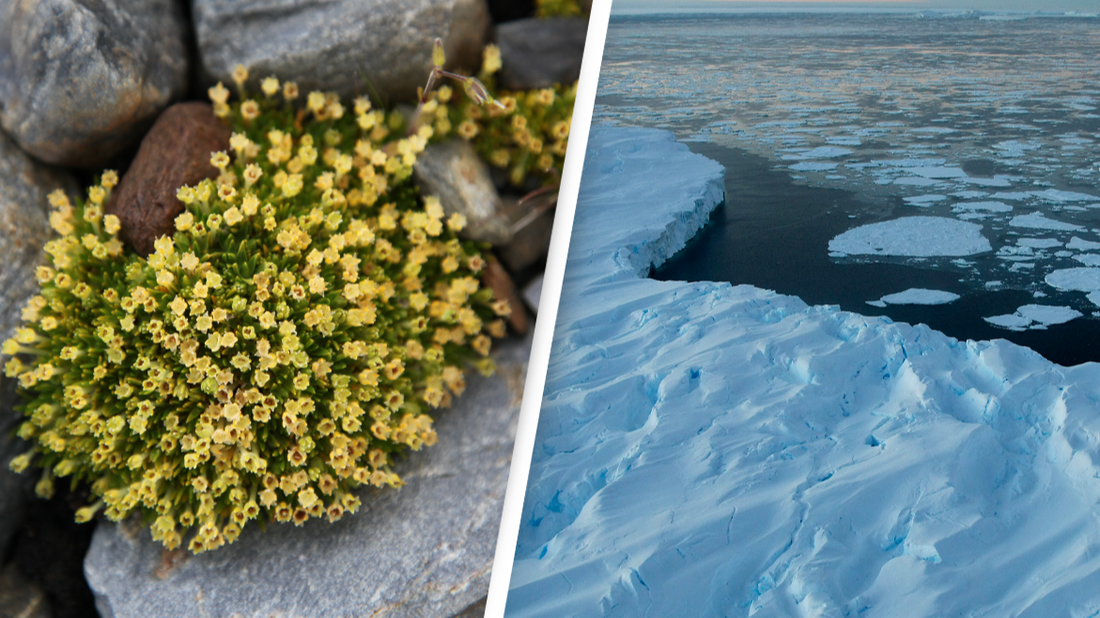
Yes, flowers are growing in Antarctica. Here's why that sucks.
Share
Antarctica, the frozen continent at the bottom of our world, is undergoing a remarkable transformation. As our planet grapples with rising temperatures due to the climate crisis, Antarctica is no longer the untouched, icy wilderness it once seemed to be.
On land, scientists have been astonished to discover the rapid spread of life in the form of flowering plants, mosses, and algae. These resilient organisms are making their mark in Antarctica's harsh environment like never before.

Vanishing Sea Ice
At sea, the situation is equally alarming. Floating sea ice in Antarctica has reached record lows, signalling a troubling shift in the region's dynamics.
Rising Temperatures
These profound changes in Antarctica are closely linked to rising summer temperatures. In 2022, researchers from the University of Washington documented the most extensive heat wave ever recorded in Antarctica.
During this event, temperatures near the south pole soared to an astonishing 39°C above the norm for three consecutive days, with a peak of -10°C. This anomaly was the most significant temperature departure observed anywhere on Earth, highlighting the scale of Antarctica's climate crisis.
Antarctica's Vulnerability to Climate Change
These startling developments underscore that Antarctica is far from immune to the consequences of the climate crisis, contrary to earlier beliefs held by some scientists.
To quantify the role of climate change in the recent heatwave, the University of Washington team employed a 'storyline approach.' This method uses historical and hypothetical scenarios to recreate present climate events.
Their findings revealed that climate change over the last century amplified the heatwave by an additional 2°C. Extrapolating this trend to a heatwave in 2096 suggests temperatures could be 6°C warmer relative to 2022, equating to an 8°C increase compared to 1922. Such a scenario could push Antarctic temperatures perilously close to the melting point, posing a significant threat to the continent's massive ice sheets.
Vegetation On the Rise
Until recently, Antarctica and its associated islands were predominantly covered by permanent snow and ice, leaving only a tiny fraction of land suitable for flowering plants like the Antarctic hair grass and the Antarctic pearlwort.
However, as spring and summer temperatures have risen in the past few decades, these resilient plants have flourished. Growth rates have surged by over 20% between 2009 and 2018. Climate models suggest that by the end of the century, ice-free land on the Antarctic Peninsula may triple in size, providing an opportunity for vegetation to colonise new regions.
While this expansion may benefit some species, it also carries the risk of "irreversible biodiversity loss" in Antarctica. The milder conditions could open the door for invasive non-native species to thrive, further complicating the fragile ecosystem.
A Race Against Time
The clock is ticking, and scientists worldwide are working tirelessly to comprehend Antarctica's changing ecosystems, both past and present. Their goal is to develop strategies to safeguard these environments for future generations, recognizing that there is no time to pause and appreciate the blossoming flora in this rapidly evolving polar landscape.
ARSE Jnr
The section where we explain the above to 5-year-olds (and Flat Earthers).
You’ve come this far…
Why not venture a little further into A.S.S. - our exclusive Australian Space Society.
And keep thrusting Australia into the deep unknown…
#Space_Aus




